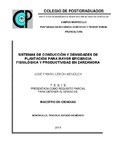Mostrar el registro sencillo del ítem
Sistemas de conducción y densidades de plantación para mayor eficiencia fisiológica y productividad e zarzamora.
| dc.contributor.author | Cerón Mendoza, José Fabián | |
| dc.creator | CERÓN MENDOZA, JOSÉ FABIÁN; 790737 | |
| dc.date.accessioned | 2020-11-25T15:59:31Z | |
| dc.date.available | 2020-11-25T15:59:31Z | |
| dc.date.issued | 2019-03 | |
| dc.identifier.uri | http://hdl.handle.net/10521/4341 | |
| dc.description | Tesis (Maestría en Ciencias, especialista en Fruticultura).- Colegio de Postgraduados, Campus Montecillo, 2019. | es_MX |
| dc.description.abstract | Las condiciones climáticas de México, permiten el desarrollo y la producción de frutos de zarzamora para consumo en fresco durante el otoño, invierno y primavera, principalmente con fines de exportación para América del Norte y la Unión Europea. En México sólo se utiliza un sistema de conducción que es espaldera sencilla, con densidades de 6,000 a 11,100 plantas/ha con 0.50 a 0.70 m entre plantas, por lo que no hay una densidad de población definida. Actualmente en frutales, se emplean sistemas de conducción y altas densidades de plantación, por unidad de superficie, para obtener un balance en la estructura de la planta y una mejor captación de luz, con la finalidad de elevar la productividad. Por lo anterior los objetivos de este estudio fueron, identificar qué sistema de conducción: espaldera sencilla, T, V y arborización permite un mejor manejo, eficiencia, desarrollo de la planta, rendimiento en Ziracuaretiro, Michoacán y en cuál distanciamiento entre plantas 0.50 m (10,000 plantas/ha) y 0.80 m (6,250 plantas/ha) se obtiene mayor rendimiento en Montecillo, Texcoco. Los resultados mostraron que en los sistemas de conducción donde se obtuvo un mayor rendimiento total, fue el sistema en T y el segundo en frutos con calidad de exportación, seguido en rendimiento total por V que presentó mayor cantidad de frutos de exportación, en comparación con los resultados del sistema en espaldera sencilla y arborización. Se encontró un mayor rendimiento en la distancia de 0.50 m con 10,000 plantas/ha. _______________ TRAINING SYSTEMS AND PLANTATION DENSITIES FOR GREATER PHYSIOLOGICAL EFFICIENCY AND PRODUCTIVITY IN ZARZAMORA. ABSTRACT: The climatic conditions of Mexico allow the development and production of fresh blackberry fruits during the fall, winter and spring, mainly for export purposes to North America and the European Union. In Mexico only the simple trellis is used as a conduction system for this crop, resulting in densities of 6,000 to 11,100 plants/ha with 0.50 to 0.70 m between plants, so it is no defined the plant density per hectare. Currently in fruit trees, conduction systems and high planting densities are used, per unit area, to obtain a balance in the structure of the plant and a better capture of light, in order to increase productivity. So the objectives of this study was to identify which system of simple trellising, T, V and arborization allows better management, efficiency, plant development and yield in Ziracuaretiro Michoacán and define which of the distances between plants 0.50 m (10,000 plants/ha) and 0.80 m (6,250 plants/ha) between plants yields higher yields in Montecillo, Texcoco. The results show that in the conduction systems where a higher total yield was obtained, it was the in T and the second in fruits with export quality, followed in total yield by V, which presented a greater amount of export fruit, compared to the results of the system in simple trellis and tree planting. A greater yield in the distance of 0.50 m was found with 10,000 plants/ha. | es_MX |
| dc.description.sponsorship | Consejo Nacional de Ciencia y Tecnología (CONACyT). | es_MX |
| dc.format | es_MX | |
| dc.language.iso | spa | es_MX |
| dc.rights.uri | http://creativecommons.org/licenses/by-nc-nd/4.0 | es_MX |
| dc.subject | Zarzamora | es_MX |
| dc.subject | Sistemas de conducción | es_MX |
| dc.subject | Densidades | es_MX |
| dc.subject | Rendimiento | es_MX |
| dc.subject | Blackberry | es_MX |
| dc.subject | Conduction systems | es_MX |
| dc.subject | Densities | es_MX |
| dc.subject | Yield | es_MX |
| dc.subject.classification | CIENCIAS AGROPECUARIAS Y BIOTECNOLOGÍA::CIENCIAS AGRARIAS::HORTICULTURA::FRUTICULTURA | es_MX |
| dc.title | Sistemas de conducción y densidades de plantación para mayor eficiencia fisiológica y productividad e zarzamora. | es_MX |
| dc.type | Tesis | es_MX |
| Tesis.contributor.advisor | Calderón Zavala, Guillermo | |
| Tesis.contributor.advisor | López Jiménez, Alfredo | |
| Tesis.contributor.advisor | Barrientos Priego, Alejandro Facundo | |
| Tesis.date.submitted | 2019-03 | |
| Tesis.date.accesioned | 2020 | |
| Tesis.date.available | 2020 | |
| Tesis.format.mimetype | es_MX | |
| Tesis.format.extent | 2,004 KB | es_MX |
| Tesis.subject.nal | Producción de cultivos | es_MX |
| Tesis.subject.nal | Crop production | es_MX |
| Tesis.subject.nal | Fisiología vegetal | es_MX |
| Tesis.subject.nal | Plant physiology | es_MX |
| Tesis.subject.nal | Espalderas | es_MX |
| Tesis.subject.nal | Trellises | es_MX |
| Tesis.subject.nal | Estructura de la vegetación | es_MX |
| Tesis.subject.nal | Vegetation structure | es_MX |
| Tesis.subject.nal | Rendimiento de la fruta | es_MX |
| Tesis.subject.nal | Fruit quality | es_MX |
| Tesis.subject.nal | Calidad de la fruta | es_MX |
| Tesis.subject.nal | Fruit yield | es_MX |
| Tesis.subject.nal | Ziracuaretiro, Michoacán, México | es_MX |
| Tesis.rights | Acceso abierto | es_MX |
| Articulos.subject.classification | Zarzamoras-cultivo | es_MX |
| dc.type.conacyt | masterThesis | es_MX |
| dc.identificator | 6||31||3107||310704 | es_MX |
| dc.contributor.director | CALDERÓN ZAVALA, GUILLERMO; 35162 | |
| dc.audience | generalPublic | es_MX |
Ficheros en el ítem
Este ítem aparece en la(s) siguiente(s) colección(ones)
-
Tesis MC, MT, MP y DC [138]
Tesis y trabajos de grado


